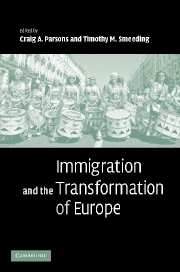Book contents
- Frontmatter
- Contents
- List of figures
- List of tables
- List of contributors
- Acknowledgements
- 1 What's unique about immigration in Europe?
- 2 Europe's immigration challenge in demographic perspective
- 3 Migration into OECD countries 1990–2000
- 4 Divergent patterns in immigrant earnings across European destinations
- 5 Economic consequences of immigration in Europe
- 6 Occupational status of immigrants in cross-national perspective: A multilevel analysis of seventeen Western societies
- 7 Immigrants, unemployment, and Europe's varying welfare regimes
- 8 How different are immigrants? A cross-country and cross-survey analysis of educational achievement
- 9 Immigration, education, and the Turkish second generation in five European nations: A comparative study
- 10 Managing transnational Islam: Muslims and the state in Western Europe
- 11 Migration mobility in European diasporic space
- 12 The new migratory Europe: Towards a proactive immigration policy?
- 13 European immigration in the people's court
- 14 The politics of immigration in France, Britain, and the United States: A transatlantic comparison
- 15 “Useful” Gastarbeiter, burdensome asylum seekers, and the second wave of welfare retrenchment: Exploring the nexus between migration and the welfare state
- 16 The European Union dimension: Supranational integration, free movement of persons, and immigration politics
- 17 The effectiveness of governments’ attempts to control unwanted migration
- Index
- References
5 - Economic consequences of immigration in Europe
Published online by Cambridge University Press: 23 June 2009
- Frontmatter
- Contents
- List of figures
- List of tables
- List of contributors
- Acknowledgements
- 1 What's unique about immigration in Europe?
- 2 Europe's immigration challenge in demographic perspective
- 3 Migration into OECD countries 1990–2000
- 4 Divergent patterns in immigrant earnings across European destinations
- 5 Economic consequences of immigration in Europe
- 6 Occupational status of immigrants in cross-national perspective: A multilevel analysis of seventeen Western societies
- 7 Immigrants, unemployment, and Europe's varying welfare regimes
- 8 How different are immigrants? A cross-country and cross-survey analysis of educational achievement
- 9 Immigration, education, and the Turkish second generation in five European nations: A comparative study
- 10 Managing transnational Islam: Muslims and the state in Western Europe
- 11 Migration mobility in European diasporic space
- 12 The new migratory Europe: Towards a proactive immigration policy?
- 13 European immigration in the people's court
- 14 The politics of immigration in France, Britain, and the United States: A transatlantic comparison
- 15 “Useful” Gastarbeiter, burdensome asylum seekers, and the second wave of welfare retrenchment: Exploring the nexus between migration and the welfare state
- 16 The European Union dimension: Supranational integration, free movement of persons, and immigration politics
- 17 The effectiveness of governments’ attempts to control unwanted migration
- Index
- References
Summary
Introduction
The migration policies of the European Union (EU) and the other Member States of the European Economic Area (EEA) are characterized by a two-fold approach. On the one hand, the free movement of labor has been defined since the Treaty of Rome (which established the EU in the 1950s) as one of the fundamental freedoms of the Common Market and has been subsequently implemented by the supranational legislation of the European Community. This integrative approach distinguishes the EU and the EEA from other regional trade agreements in the world such as NAFTA. On the other hand, the individual Member States of the EU and the EEA decide on immigration policies vis-à-vis third-country nationals. Most Member States have pursued a restrictive migration policy since the first oil-price shock in 1973. Aggregate migration figures reflect this restrictive approach: although the income gap on the European continent and between Europe and its neighboring regions resembles that between North and South America (Brücker 2002), annual net immigration rates in the EU and the EEA have only been half those of the United States and Canada (2.2 persons per thousand versus 4.4 per thousand) during the 1990s and early 2000s.
The restrictive immigration policies of the EU and the EEA vis-à-vis third countries face three main challenges today.
- Type
- Chapter
- Information
- Immigration and the Transformation of Europe , pp. 111 - 146Publisher: Cambridge University PressPrint publication year: 2006
References
- 3
- Cited by



